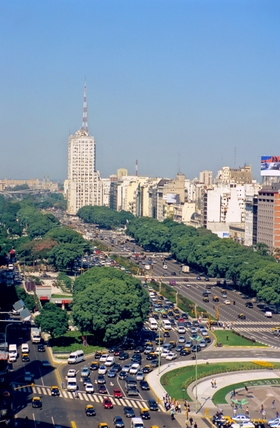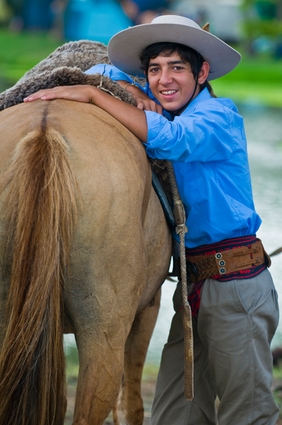Argentine Literary Authors
 Argentina Argentina has a long and rich literary history. In fact, Argentina received its name from a poem by one of the first Argentine authors. Martin del Barco Centenera was born in 1535 and died in 1602. He wrote the poem La Argentina in 1602 and helped make Argentina a popular name for the country. Although he was born at Logrosán, Spain, he traveled to South America as part of the expedition of Juan Ortiz de Zarate. Through his lens, his written works depicted close to 25 years of the Spanish undertaking in Argentina and other South American countries.
Argentina Argentina has a long and rich literary history. In fact, Argentina received its name from a poem by one of the first Argentine authors. Martin del Barco Centenera was born in 1535 and died in 1602. He wrote the poem La Argentina in 1602 and helped make Argentina a popular name for the country. Although he was born at Logrosán, Spain, he traveled to South America as part of the expedition of Juan Ortiz de Zarate. Through his lens, his written works depicted close to 25 years of the Spanish undertaking in Argentina and other South American countries.
It appears that early Argentine writing was inspired by the oral poetry of the aboriginal tribes. Writers combined the style of the aboriginal tribes and Spanish traditions in order to create a new, unique literary style. Some of the first authors to combine this approach were Matías Rojas de Oquendo and Pedro González de Prado. These early authors set the stage for future Argentine authors to emerge and build their own styles.
Miscellaneous Authors of Argentina
By the 19th century, Argentine authors were influenced by an influx of European immigrants. This social order was bombarded with literary works from the likes of Smith, Voltaire, and Rousseau. These early authors became an inspiration to the many that followed thereafter.
One of these inspired was a well known intellectual author named Mariano Moreno who was born in 1778 and died in 1811. In addition to these intellectual works entering the writing scene, another popular literary culture was created. It was a culture depicting the music and stories of the gauchos known for herding cattle. Around the mid 1800s, these gaucho poets traveled throughout Argentina telling their stories of political turmoil and struggles. They showed this by depicting the various conflicts and ruling politicians of that time; Quiroga and Rosas in not so favorable light. A famous written work was completed by capturing the biography of Gaucho Facunda through allegory. It was written by Domingo Faustino Sarmiento. Other great works such as the famous Gaucho poems of El Gaucho Martin Fierro (1872) and its sequel La Vuelta de Martin Fierro (1879) were written by Jose Hernandez.
As Argentina was trying to gain their independence from Spanish authors, they experimented with different styles of writing from other countries. As an activist and a writer, Esteban Echeverría was one of the first to break away from using Spanish style writing. He began by implementing the use of romanticism through his poetry and short fiction stories. One of his most famous novels is called El Matadero, “The Slaughterhouse” in English. This story features the Pampas, an area of Argentina, as its setting. Other activists and authors were also influenced by the reign of Juan Manuel de Rosas, elected governor of Buenos Aires. Many of these authors began to write about this time in history. Lots of novels and poems were published in opposition to Rosas’ form of rule, and as a result many of these authors were sent into exile because of their criticism of the regime.
Writers in Argentina continued to borrow styles from Europe until the end of the 19th century. By the late 1800s and early 1900s, modernism had been introduced into Argentina and many authors had embraced this. Leopoldo Lugones, a great poet and inspired by the great Nicaraguan poet Rubén Darío, wrote on issues that were of a nationalist nature, but also continued to carry gaucho themes. In addition, Leopoldo Lugones became the first author to publish the first Argentine science fiction novel. These early authors of modernism continued to pursue a wide variety of themes within their writing. Modernism remained the dominant style of writing up until the 1950’s, after World War II. Thereafter, humanism became the new wave. This new approach began to include the personal reflection and emotional toll of the war on the Argentines.
 In the early 20th century, a complex urban society had evolved along with a new literary world. This gave the world the Argentine author Jorge Luis Borges. His focus became the ever changing urban landscapes in Buenos Aires through his poetry and stories. In the mid 1900s, literary intellectuals such as Julio Cortázar and Ernesto Sábato began an attack on the Argentine elite and caused people to stand up and notice. Other writers such as Victoria Ocampo Aguirre became the editor and publisher of a legendary magazine called Sur (South).
In the early 20th century, a complex urban society had evolved along with a new literary world. This gave the world the Argentine author Jorge Luis Borges. His focus became the ever changing urban landscapes in Buenos Aires through his poetry and stories. In the mid 1900s, literary intellectuals such as Julio Cortázar and Ernesto Sábato began an attack on the Argentine elite and caused people to stand up and notice. Other writers such as Victoria Ocampo Aguirre became the editor and publisher of a legendary magazine called Sur (South).
As more modern times approached, new authors came on the scene. Writers like Beatriz Guido and Silvina Bullrich wrote engaging accounts of those times and focused on the social problems in Argentina. Eventually, the social and political issues in Argentina culminated to a military coup during the 1970’s. Consequently, many authors were again forced into exile. The authors who did stay wrote pieces that hid their opposition to the regime. One of those authors was Liliana Heker. She stayed in Argentina and did her best to hide her criticism of the regime in her work. Her writings were comprised with left-wing agendas and against the state sponsored violence during the 1970s and 1980s. In order to publish her works she had to work under the guise of different names and techniques to make her critiques known.
Authors who disappeared during this tumultuous time were Haroldo Conti and Rodolfo Walsh as well as many other authors’ and their families. These times also brought other great novelists such as the Colombian author Gabriel García Márquez who published with an Argentine publishing house. Her book, Cien años de soledad (One Hundred Years of Solitude) has become one of the best-selling novels within this century. In 1983, after Alfonsín’s election victory, many cultural freedoms were finally realized. It was during this time that the author Ernesto Sábato headed up a committee to investigate the disappearance of the many citizens during the war torn times of Argentina.
Publishing In Argentina
Today, Argentina enjoys a great range of writers, journalists, and poets. Most publishing houses are located in Buenos Aires, the capital of Argentina. From large corporation to small independent businesses, there are a variety of different publishing companies an author can choose to work with in Argentina. Most publishing companies in Argentina belong to international publishing houses, and many publishing companies have specific work they like to take in. This means getting published is as easy as finding a company that shares the same interests as the author. The best part about publishing in Argentina is that Argentines are one of the biggest purchasers of books in Latin America so there won’t be a lack of customers.
Just like back then, the writers of Argentina today still continue to develop their style and themes around the ever changing political and social climate of Argentina. Many of these themes are still centered on finding a clear single unified identity for the population, which most probably continues to exist due to the high influx of immigrating groups that historically and currently enter the country. This immigration, along with highly unpredictable government changes, makes a complex yet stimulating time to be Argentine.




